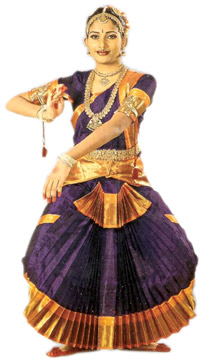Existing style of Bharatha Natyam
Subashini Pathmanathan
Silapathikaram, the ancient Tamil classic, was written by Ilango
Adigal. He was of royal lineage but he renounced his heritage and became
an ascetic. His greatest contribution to Tamil literature was the epic
Silapathikaram.
 |
|
Bharatha Natyam influenced many kinds
of other dances |
|
Bharatha
Natyam history |
| * Silapathikaram is written by Ilango Adigal
* It is a unique work which deals with moral values
* It has references to dance as well as stage decor
* Adavus are fundamental in any dance
* Differences are accredited to each teacher
|
Silapathikaram is a unique work, which deals with moral values,
literature, government, justice, social values, religious values,
uniqueness of dance dedicated to gods and popular dances of his time.
Silapathikaram gives us an insight into Tamil civilization as it existed
at the time of his writing, which is popularly believed to be the Second
Century AD.
Dealing with dance, Ilango Adigal describes how a dance teacher
should set about his work, how sidemen (accompanists) should function,
and also deals with the composition of the songs and the rendering of
it.
He also deals with stage décor - how a stage décor should be set. In
ancient times, dances were called koothu. Women dancers were called
koothiar and male dancers were called koothar. The custom then was to
reward the dancers with endowments of lands. Even to this day, a village
in Tamil Nadu is called Kootha Nallur, which means a village granted to
Koothiar.
In dance, generally Adavu means the steps. The Adavu are used in
Tamil classical dance Bharatha Natyam, and Sinhala classical dance –
(Kandyan Dance). Even to this day, the term Adavu is used in Tamil and
Sinhala dances. It appears that there was an interaction between the
classical dances of India and Sri Lanka. Kandyan dance is almost purely
Nirtha dance, firmly based on pure Nirtha and on Thala and Laya.
Adavus are fundamentals in any dance, and these Adavus are generally
common to all dances, but in the execution of Adavus slight variations
are discernable. These differences are mainly due to different
approaches of different teachers, stationed in different areas. These
slight differences have given rise to popular misconception that there
are different types of Bharatha Natyam. Bharatha Natyam is one. Eye
movements, neck movements, body positions, leg positions and movements,
hand positions and hand movements, hand gestures, divisions of Abhinaya,
division of Bhavas and division of Rasas are same in any Bharatha
Natyam, taught by different Gurus.
Even in the streams of Adavus, there is no difference. Some of the
main Adavus are Thadu Adavu, Naat Adavu, Kuthu Meddu Adavu, Sarikai
Adavu, Pakka Adavu, Paachal Adavu, Marthitha Adavu, Nadai Adavu, and
some of the main and important Adavus.
Differences, if any, arise out of the methodology of different Gurus,
in the inner subdivision of Adavus. It is these differences that have
been given rise to the so- called styles in Bharatha Natyam.
The four different well known styles are Pantha Nallur, Vazhuvuoor,
Thanjavur and Kanchipuram. The Thanjavur and Kachipuram have virtually
disappeared.
The two popular styles or schools still exist are Vazhuvoor and Panda
Nallur. There is no main difference between these two styles, except in
the execution of inner sub Adavus.
There are quite a number of people who speak of Kalashethra style or
Adyar style. This is a gross misconception. Kalashethra is an
institution situated in Adyar founded by Smt Rukmani Devi who herself
was trained by Panda Nallur Gurus.
Panda Nallur style still follows the traditional patterns and frowns
upon the innovations made in some institutions. The present Gurus of
Panda Nallur schools still adhere to the classical standards.
The Vazhuvoor style remains the same and adheres to the classical
traditions. It has not moved to institutions. Because it is taught by
certain families of Vazhuvoor and those who trained in Vazuvoor
tradition continue to maintain the purity of the same tradition and
dance. Generally teaching Bharatha Natyam in institutions is not a
healthy development. However it may help the general public gain some
knowledge about the art. In institutions the art is taught to a set
syllabus within a time frame which tends to emasculate the art and leads
to a craze for certificate.
Earlier the Sathir dances were trained by a particular clan, it was
not institutionalized. Any art whether it is music or dance must be
learnt under one particular Guru. Under a Guru, one imbibes the art,
while in an institution one learns the art. There is a world of
difference between imbibing the art and learning the art.
In Kathak there are four main styles: Lucknow style, Rampur style,
Jaipur style and Varansi style. However in Kathak also there are two
main popular styles or schools. Nevertheless the fundamental are the
same.
The Lucknow and Jaipur styles are more popular in Kathak. So too in
martial arts there are different styles.
Generally style is a work of individual teachers but it has not
changed the basic aspect of dance or any arts. Bharatha Natyam remains
Bharatha Natyam whatever the styles may be.
|



